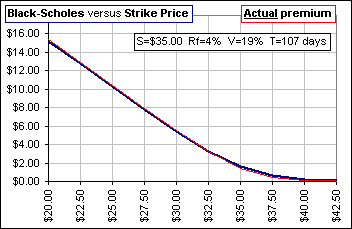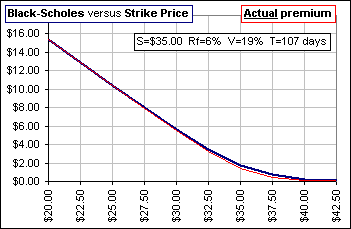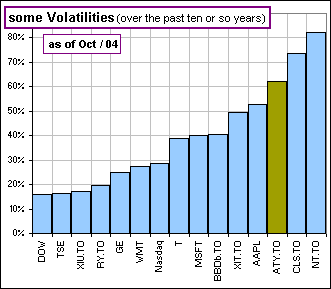| Volatility and Black-Scholes |
Okay, so we need to determine some Volatility value so we can stick into the
Black-Scholes formula.
In Excel, that'd be:
B-S = S*NORMSDIST((LN(S/K)+(Rf+V^2/2)*T)/(V*SQRT(T))) - K*EXP(-Rf*T)*NORMSDIST((LN(S/K)+(Rf+V^2/2)*T)/(V*SQRT(T))-V*SQRT(T))Should we use the Standard Deviation of annual returns over the past umpteen years
where
S = Stock Price
K = Strike Price
Rf = Risk-free Rate
V = Volatility
T = Time (in years) to expiry
or maybe the Standard Deviation of monthly returns (multiplied by SQRT(12) to get an "annualized" number)
or maybe the Standard Deviation of daily returns (annualized !)
and then there's the question of which magic formula should one use to calculate Standard Deviation and ...
>Huh?
The way to calculate Standard Deviation or Volatility varies from one guru to another. For example:
- To determine a stock's historical volatility, calculate the equilibrium level (midpoint) of a stock's price range. Then simply divide the difference between the high point and the equilibrium level by the equilibrium level to get the volatility percentage.
- Volatility is found by calculating the annualized standard deviation SD of daily change in price
 where ??? is either N or N-1
where ??? is either N or N-1 
- or maybe
 where Pt is the stock price at time t
where Pt is the stock price at time t
- or maybe ...
|
>So?
Presumably, for Black-Scholes, one wants a Volatility number which gives a good estimate of the actual value at which the option is currently trading. That is ... >Pick the definition that best fits the current option premium, right?
>And you'll use that to bid on an option?
For example, I look at GE call options and the current GE stock price and I fiddle with the Risk-free rate and
Volatility value and get the charts here First I notice that changing Rf, the Risk-free Rate, isn't as important as picking a good V .. that's the Volatility. >The Risk-free might be 2% to 6% ...
|   
|
>And, to make a long story short ...?
Uh ... yes. There's a spreadsheet.
It looks like this:

Click on the picture to get the spreadsheet
... and play with the numbers 
>And did you play ... to find the best value for Volatility?
Yes, and I found that using the Standard Deviation of monthly returns for the past year
(multiplied by SQRT(12) to get an "annualized" number)
gave a good result. I also used SD, from #3 above, with ??? = N.
>And that's the correct choice?
Define "correct".


